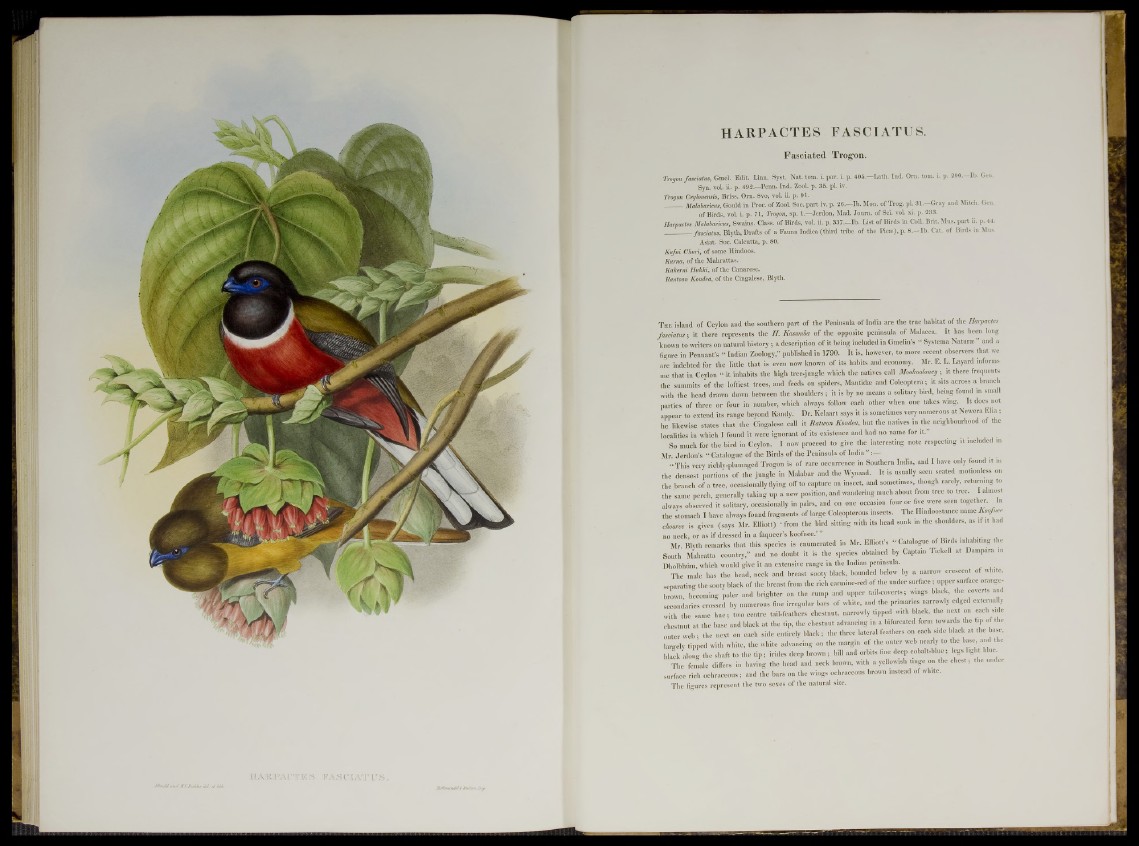
Fasciated Trogon.
Tragón fasciatus, Gmel. Edit. Linn. Syst. Nat. tom. i. par. i, p. 405.—Lath. Ind. Om. tom. i. p. 200.—Ib. Gen.
Syn. vol. ii. p. 492.—Penn. Ind. Zool. p. 35. pi. iv.
Trogon Ceylonensis, Briss. Orn. 8vo, vol. ii. p. 91.
Mahlaricm, Gould in Prod, of Zool. Soc. p a rt iv. p. 26 —Ib. Mon. of Trog. pi. 31.—Gray and Mitch. Gen.
of Birds, vol. i. p. 71, Trogon, sp. I —Jerdon, Mad. Joum. of Sci. vol. xi. p. 233.
Harpactes Malabaricus, Swains. Class, of Birds, vol. ii. p. 337—Ib. List of Birds in Coll. Brit. Mus. p art ii. p. 44.
________ fasciatus, Blyth, Drafts of a Fauna Indica (third tribe of the Picse), p. 8.—Ib. Cat. of Birds in Mus.
Asiat, Soc. Calcutta, p. 80.
Kufni Churi, of some Hindoos.
Kuma, of the Mahrattas.
Kakemi Huhhi, of the Canarese.
Rantvan Kondea, of the Cingalese, Blyth.
The island of Ceylon and the southern part of the Peninsula of India are the true habitat of the Harpactes
fasciatus; it there represents the H. Kasumba of the opposite peninsula of Malacca. It has been long
known to writers on natural history ; a description of it being included in Gmelin’s “ Systema Naturae and a
figure in Pennant's “ Indian Zoology," published in 1790. It is, however, to more recent observers that we
are indebted for the little that is even now known of its habits and economy. Mr. E. L. Layard informs
me that in Ceylon “ it inhabits the high tree-jungle which the natives call Mookoolancy ; it there frequents
the summits of the loftiest trees, and feeds on spiders, Mantillas and Coleóptera; it sits across a branch
with the head drawn down between the shoulders ; it is by no means a solitary bird, being found in small
parties of three or four in number, which always follow each other when one takes wing. It does not
appear to extend its range beyond Kandy. Dr. Kelaart says it is sometimes very numerous at Newera Elia;
he likewise states that the Cingalese call it Ra ima Kondea, but the natives in the neighbourhood of the
localities in which I found it were ignorant of its existence and had no name for it.”
So much for the bird in Ceylon. I now proceed to give the interesting note respecting it included in
Mr. Jerdon’s “ Catalogue of the Birds of the Peninsula of India ¿ „
“ This very richly-plumaged Trogon is of rare occurrence in Southern India, and I have only found it in
the densest portions of the jungle in Malabar and the Wynaad. It is usually seen seated motionless on
the branch of a tree, occasionally flying off to capture an insect, and sometimes, though rarely, returning to
the same perch, generally taking up a new position, and wandering much about from tree to tree. I almost
always observed it solitary, occasionally in pairs, and on one occasion four or five were seen together. In
the stomach I have always found fragments of large Coleopterous insects. The Hindoostanee name Koofaec
chooree is given (says Mr. Elliott) ‘ from the bird sitting with its head sunk in the shoulders, as if it had
n o neck, or as if dressed in a faqneer’s koofnee.” '
Mr. Blyth remarks that this species is enumerated in Mr. Elliott's “ Catalogue of Birds inhabiting the
South Mahratta country,” and no doubt it is the species obtained by Captain Tickeil at Dampara in
Dholbhiim, which would give it an extensive range in the Indian peninsula.
The male has the head, neck and breast sooty black, bounded below by a narrow crescent of white,
separating the sooty black of the breast from the rich carmine-red of the under surface; upper surface orange-
brown, becoming paler and brighter on the rump and upper tail-coverts; wings black, the coverts and
secondaries crossed by numerous fine irregular bars of white, and the primaries narrowly edged externally
with the same hue; two centre tail-feathers chestnut, narrowly tipped with black, the next on each side
chestnut at the base and black at the tip, the chestnut advancing in a bifurcated form towards the tip of t e
outer web- the next on each side entirely black; the three lateral feathers on each side black at the base,
largely tipped with white, the white advancing on the margin of the outer web nearly to the base and the
black along the shaft to the tip; irides deep brown; bill and orbits fine deep cobalt-blnc; legs light blue
The female differs in having the head and neck brown, with a yellowish tinge on the chest; the under
surface rich ochraceous; and the bars on the wings ochraceous brown instead of white.
The figures represent the two sexes of the natural size.